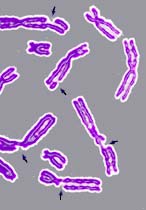 |
|
|
When an organism is exposed to radiation, the amount of damage it suffers will depend on the energy carried by the radiation. Ionizing radiation carries sufficient energy to be dangerous to living cells. Several things can happen when ionizing radiation hits a living cell:
If the cell is a sex cell, the radiation may cause a mutation in a gene. HoweverMassive cell death can sometimes be beneficial. In a radiotherapy treatment, for example, a tumour may be eradicated by submitting it to intense X-rays. Lower energy radiation such as UV Light can still cause painful sunburn and has been linked to skin cancer. ETHICAL ISSUES INVOLVED
|



 Measuring radiation and risk
Measuring radiation and risk

What's your opinion?
Average rating




Current rating: 5/5 (from 1 votes cast)